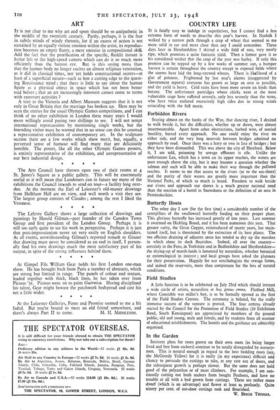ART
IT is not clear to me why art and sport should be so antipathetic in the middle of the twentieth century. Partly, perhaps, it is the fear in subtle minds of windy rhetoric, for if an excess of action is not sustained by an equally violent emotion within the artist, its reproduc- tion becomes an empty flurry, a mere exercise in compositional skis. Add the fact that the petrification of the specific, flashlit instant is better left to the high-speed camera which can do it so much more efficiently than the human eye. But is this saying more than that the human body no longer excites an almost religious veneration, as it did in classical times, nor yet holds constructional secrets—at least of a superficial nature—such as lent a cutting edge to the quest- ing Renaissance mind ; that there is little to say about the human figure as a physical object in space which has not been better said before ; that an art increasingly introvert cannot come to terms with extrovert activities ?
A visit to the Victoria and Albert Museum suggests that it is not only in Great Britain that the marriage has broken tin. Here may be seen the entries for the usual Olynipic Games competitions, and I can think of no other exhibition in London these many years I would more willingly avoid paying two shillings to see. I will not tempt international repercussions by mentioning single works, but the intending visitor must be warned that in no sense can this be counted a representative exhibition of contemporary art. In the sculpture• section there are a few works which show merit, but, equally, a perverted sense of humour will find many that are deliciously horrible. The poster, like all the other Olympic Games posters, is entirely representative of the exhibition, and unrepresentative of our best industrial design.
The Arts Council have thrown open two of their rooms at 4 St. James's Square as a public gallery. This will be enormously useful as it will mean that Londoners can in future see many of the exhibitions the Council intends to send on tour—a facility long over- due. At the moment the Earl of Leicester's old-master drawings from Holkham Hall are on view, and well worth a visit they are. The largest group consists of Claudes ; among the rest I liked the Veronese.
* * *
The Lefevre Gallery shows a large collection of drawings and paintings by Harold Gilman—part founder of the Camden Town Group and first president of the London Group. Perhaps it is still too early quite to see his work in perspective. Perhaps it is just that post-impressionism never sat very easily on English shoulders. At all events, notwithstanding Gilman's reported remark to Ginner that drawing must never be considered as an end in itself, I person- ally find his own drawings much the most satisfactory part of his output, in spite of the strong influences behind them.
* *
At Gimpel Fils William Gear holds his first London one-man show. He has brought back from Paris a number of abstracts, which are strong but limited in range. The panels of colour and texture, leaded together with thick, black' liness he has taken over from Picasso '31. Picasso went on to paint Guernica. Having disciplined his talent, Gear might beware the patchwork bedspread and cast his net a little wider.
At the Leicester Galleries, Fame and Promise seemed to me a bit faded. But you're bound to meet an old friend somewhere, and


































 Previous page
Previous page